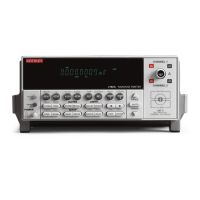Delta, Pulse Delta, and Differential Conductance I-3
Operation overview
The Model 6220 or 6221 Current Source can be used with a Model 2182/2182A Nanovolt-
meter to perform Delta and Differential Conductance. The Model 2182A/6221 combina-
tion can also perform Pulse Delta. These operations use a delta current-reversal technique
to cancel the effects of thermal EMFs.
The Model 622x provides a bipolar output current and the Model 2182/2182A performs
A/D conversions (measurements) at source high and source low points. An averaging algo-
rithm is then used to calculate the delta reading.
Delta
– The Model 622x provides a square wave current output, and the Model 2182/
2182A performs A/D conversions (measurements) at each high and low output level. A
3-point moving-average algorithm is used to calculate Delta readings.
As shown in Figure I-1A, the first three Model 2182/2182A A/D conversions (measure-
ments) yields the first Delta reading. Each subsequent Model 2182/2182A A/D conversion
then yields a single Delta reading. Every Delta reading uses the three previous A/Ds to cal-
culate Delta.
Pulse Delta
– The Model 6221 outputs pulses and uses 3-point repeating-average
measurements to calculate Pulse Delta voltage. For each pulse, the Model 2182A performs
an A/D conversion (measurement) at pulse low, pulse high, and pulse low. Each set of
three A/D readings yield a single Pulse Delta reading. Figure I-1B shows Pulse Delta
measurements. If device heating is a concern, 2-point measurements can instead be used
(2nd low pulse not measured due to corruption from heat).
Differential Conductance
– The Model 622x outputs a differential current (dI) sweep and
measures differential voltage (dV). This function uses a 3-point moving average algorithm
to calculate dV. With dI known and dV calculated, the Model 622x can then calculate dif-
ferential conductance (dG) or differential resistance (dR). Figure I-1C shows Differential
Conductance measurements.

